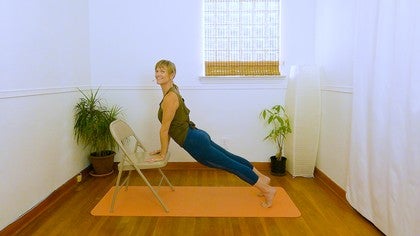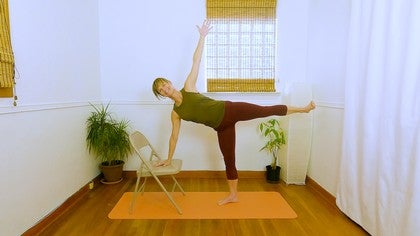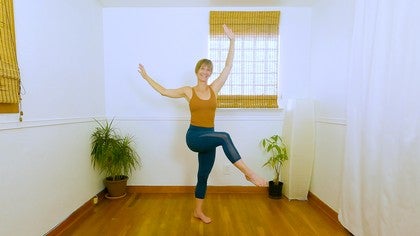Description
About This Video
Transcript
Read Full Transcript
Hi, I'm Allie Greene and this is class five, Find Your Balance. Balance can refer to physical, psychological, emotional, life balance and I think it's deeply related to support and trust. Our physical balance has everything to do with gravity and space. It's really the art of falling and catching yourself. It's fluid.
Many times, we have this image of balance being those scales that are completely even, and I think we all know that's not really life. I love the image of the zen rock formations. Those are those amazing formations where the rocks are all different shapes and sizes and they're like precariously balanced out in one area and you're just like, how is that all getting balanced? And it has to do with support. Sometimes, we just need a little bit more support in one place so that another part of us can go ahead and reach without falling.
It's really about our ability to respond, rather than react. It's less to do with being even or being still. So, for this class, we're going to use a chair again. So you can go get your chair, meet me back here. If you already have your chair, we're gonna take a seat together.
And let's do a little pre-practice observation. I invite you to close your eyes and answer this question for yourself. What is my relationship to balance? Is it hard? Or is it complicated?
For most of us, it's a bit complicated. I wanna remind you that you don't need to find your balance. You're going to create it. And balance is quite personal. So, let's begin with our feet.
So, eventually, we're gonna get off the chair and we want our feet to be ready for that moment. So, just bringing up your right foot and give it a little massage. If for any reason, this is not a comfortable position for you, you can just keep your foot on the floor and massage away, figure out a way that it works for you. So we're doing a beautiful touch. You can get in between the toes.
You can wiggle them around. You can move right up through that arch. So, this touch is helping us know where we are. It's also improving our circulation. It's hydrating tissue.
So all of that is support. Also, reminding us of relationship. So, our foot, coming all the way up the leg, we can get to the knee, give a little massage to the thigh. Come up to that pelvic half. This all grew together, it knows itself.
And then, just one more trip right back down. Now, we didn't spend a ton of time doing this, but go ahead and take a look. You might notice your circulation is already different, your feet are a different color. So let's do the other side. So getting in between the toes, and you could spend a lot more time doing this.
I really try to have a regular massage practice with myself, especially when it comes to the feet. I live in Pittsburgh, so summertime, awesome. I can be outside, I can be in my bare feet all day long, but come winter, no way. So, we need to put socks and shoes on. But that really impedes our ability to feel our feet.
So just by giving yourself a little practice of this keeps all of that awareness alive and definitely important for our balance when we're standing. So go on up that leg, give a little massage. If you feel a spot that's kind of talking to you and saying pay a little more attention to me, you can go ahead and pay a little bit more attention. Coming on up. We're really growing our sensory palette in these classes.
So we never wanna run over something we feel. We can pause, investigate and come all the way up to that pelvic half on that side. And then, let's just take that brush down one more time. Now, the other thing about our feet is they balance the front and the back of the body. So let's use our hands.
Come on down and trace your first three toes. Trace them right up to your ankle. Trace them right up to your shins, right up through the inner thighs and it goes right up the pelvic floor, right up the front of the spine, boom, front body. Let's do the other two toes. Tracing, it goes back to the heel.
Goes right up this other lower leg bone, and it's gonna come right up the back of the thighs, right up through that joint of your sacrum and your hip bones. It's called the SI joint, and it goes shoot, right up the back of the body. So we balance the feet. We also help to balance the body. And our tail is like a little rudder.
So we're gonna explore that on this next little practice. I like to call this spinal flow. So I want you to bring in all of those beautiful images of water. So we're gonna open the legs and flow up. Nice little push of the tail.
So this is like a fountain. All the way up. We're gonna flow over. Now, if going upside down makes you dizzy, just keep your eyes forwards and you can do the spinal movement. If it's okay for you to go, go all the way down, look under your chair, and roll yourself up.
So, we have this beautiful fountain flowing up. We have a waterfall going forwards and a little bit of an undertow. Let's do two more of these. And guess what we're doing? We're balancing.
We're falling, but we're catching ourselves. Our source of support changes. Let's do one more. Over we go. And return.
What if we were to reverse that? What if we were to dive under the wave and then come on up, channel your inner dolphin and then flow back down? So we're changing the support from our feet to our sits bones on the chair. We're practicing balancing, whoa, in a different relationship to gravity than just standing. One more time.
And in different relationships of support. It helps condition us for when we move into bigger balance challenges. So, let's just take a little pause there. Even when we're still, we're not. This is balancing.
So, let's bring the feet in and come right to the edge of the chair and we're gonna go into our heels and toes. So, just going up to the tippy toes and then the heels. This is creating spiraling movements from the feet all the way up to the pelvic halves. This is actually creating a little bit of mobility and strengthening work. So there's a nice balance, mobile stable.
And let's do this a couple more times. It's moving through. You could even put your hands on your hip bones and notice how those are also moving with your feet, but you're very quiet in the middle. Beautiful. Ah! And then we'll take a little pause here.
Now, we'll open the feet just a little bit wider and begin a little sway. What are we doing? We're balancing. We're like literally like kind of falling and catching ourselves on our feet. So remember, balance is personal, it's very individual.
Your balancing is your business. It doesn't need to look like anybody else's. Your practice is yours. So we can take this a little bit bigger and we're gonna turn towards the right here and we're pivoting. So, here we go with that relationship, right on up the hip.
This is pushing me onto the sits bones. This is balance, coming all the way around my chair. I can just keep on turning. And then returning back. And we can try that on the other side.
So we start with the feet, we spiral on up, we go to the hip. Whoop, there's that little balance point onto one pelvic half and spiraling around, and then returning. Let's do it. I don't know, maybe a couple more times. It's kind of fun.
And then what if we let the arms be free? Let them explore the space. So, we have balance of our yield and push from the ground, balance of reach and pull into space. Moving from one sits bone to the other. All of this is balance.
Now, we're like those zen rock formations, right? We're not straight up and down doing this. So one part of us has a little bit more support, so the other parts of us can go ahead out and explore. And how about one more time to the other side? Feeling that shift.
Balance and then returning. Come on back. Let's take a pause. Always nice to pause. Mmm.
Now, to move into some side swings. So, we take the legs wide. This is a little work for our vestibular system, inner ear. So if swinging around down there is gonna make you dizzy, you can simply stay up higher. Let's start this slow.
We're going to bring the right arm up, over you go. And then down. Feel that shift of weight support changes, we balance. Now, switch hands. Come around and come on back up.
And then flow it over to the other side. So balance is fluid. We're gonna find it in our movement. We're working on the art of falling and catching ourselves. Like what if we added this?
Whoa, that's a balance. And return, swinging down. Now, we're gonna keep this at a, I'm gonna say reasonable pace, but you could always practice this a little faster and really find a suspend and release. And over we go. One more time.
Try that little lean. Whoa! You caught yourself. And then return. And last time to the other side. Over we go.
Feel how the support changes. And back up. And we pause. Balance of doing and being. It's a great thing to practice.
That's a balance practice. So, we're gonna move into an extended side angle. I like to shift, so this sits bone, my right sits bone is actually off the chair. But remember, balance is personal and support is everything. So you can always find a place that works for you.
We do not need to look the same. If having this leg way out here doesn't feel good for your hip, this still counts. So find the support that you need. And we come forward and then flow over. Up we go.
Now, this forearm here is supporting me, but I'm gonna rotate. Let's go. We're gonna rotate down towards the ground. What are we doing? We're like in a slow motion fall, and the support changes.
You could even put your hand, I could lift my hip up off of the chair and I'm balanced. Come back down. Push to come up. Let's try that again. Over we go.
Rotating around, whoa, falling, catching myself. And push to come up. And return. Slide over to the other side. Here we go.
Find what works for you. You might notice you need something different on one side to the other. We're not really symmetrical and that's okay. Balance. So here we go, over.
Take that rotation around. How far do you wanna go? You always want to feel support. It's gonna shift, but you can feel support. So you could go all the way down to the ground.
You could lift up off the chair, put yourself back down. Use that arm to push. Bring yourself up and around. And let's go again. Over we go Coming around.
Feel that shift, and there's rebound. Remember, you're nice and fluid and push. And up. And let's return back to the center. So, we had all of that kind of asymmetrical stuff happening.
It can feel really nice to come back to a position that's a little bit more organized around your center. And those are our developmental patterns. So, let's use this position and we are going to do sit to stand. Sit to stand is a balance, for sure. So, the feet can come underneath of you until you find that they support you.
And I really encourage like lots of kind of wiggling and feel where you are in space. And then, you can push from those feet. There's our little balance. Come up in space. And then we're gonna come back down.
Let gravity take you. Space will support you. Balance and return. This is always the place where you know no one else is in the room with you but you swear someone moved your chair. (laughs) So, it takes some trust, right? So, you can always put your hand back there to make sure it's still there.
And maybe you need a little more support doing this. So, you could use your hands on the chair or your hands on your legs, a little bit more support. Ah! And let's just do one more and we're gonna come up to standing. And take a pause. It's a journey from sitting to standing.
We're gonna move our chair and use the top of the chair for little balance. You can use it with your whole hand. You could use just a couple fingertips. You could have your hand away but know that it's there. Okay?
So again, it's that trust. But it's much easier to have trust when we feel like we know where our support is. So standing with the heels in line, with the hips in the front, just do a little rocking back and forth. This is balance. Can we find fluidness?
So, your body might have that wave-like quality to it, because balance really is about our relationship with gravity and space and it's our fluid body that starts that. We can yield into the ground if we're falling. We can also reach and pull into space to slow that fall down. And what if we went side to side? And I love this because look where we're actually going.
We're making these little figure eights. So, we have these feet and legs and pelvic halves, they grew together. But your tail and your sacrum, they belong to the spine. So now your tail can be a little rudder. And what is a rudder going to help us do?
Change direction, help us balance. And then, let's just slow that down. Come into stillness, which we know really isn't still. And pause. Let's try rising up.
We can just put our hand on our hip. Rise up onto the balls of the feet, and lower down. Now, remember those toes that we talked about. When you rise up, can you press through those first three toes? You'll feel the other two toes there, but not as much as the first three.
When you lower down, can you find the middle of the heel? Press up, so we are rising and lowering with our beautiful tripod feet. We're balancing the front and the back of the body. Let's do one more. And returning down.
Now, let's put that tail to some good use. We're going to take the outside foot forwards, inside foot back. How big, your business. So I like to call these train track legs. We're separate, but we're still wide.
We have a wide base. And from here, let's try to rise up and lower down. And can you still feel the tripod feet, so that the big toe mound, remember how we trace that? It's really coming up and connecting into the front of the body. When we have that beautiful clear center, let's do one more, then we're able to organize ourselves around it.
It helps us balance. Now, we're gonna take this foot and we're gonna go from train track to tightrope. So, we're narrowing our foundation. And here we go, let's try it. See what that feels like.
And you can play around with this hand on the chair. It's there if you need it. How you doing? I went quiet, right? 'Cause I'm concentrating.
One more. This gets a little bit more challenging. And lower. Now, let's do our heel to toe. And we're gonna walk the line, so the back foot can come forwards, heel to toe.
And you could do that again. Maybe a little lift, and then put that foot back down. Take a walk back. We could do another one. Now, there's a couple of different ways you could challenge your balance here.
You could take your hand away. You could also keep your hand, but close your eyes. Lots of different ways to work on our balance. And let's just go back one more time. Take a little pause and shake it out.
We're gonna do all of that on the other side. So we could move our chair around. And here we are. So, we could practice closing our eyes for any of these. So, if that's something you wanna practice on this side, feel free and then just make sure you have support because we want to stay relaxed, so we're just gonna rise and lower.
We wanna stay fluid. Yeah, little rise and lower. You can play around with tempo. You could go fast and then you could go slow. Kind of try to trick yourself.
Last one. And we lower down. Let's move into train tracks. Now remember, we're not symmetrical, so one side might feel really different than the other. So rising up, you're gonna try to feel those tripod feet all the way up through the inner thigh and lower back down.
And we rise. And if you're getting all those little wiggle wobbles like I am, that's good stuff. Those are little falls and catches. And one more. And lower.
Let's move into our little tightrope. And here we go, let's do four here. Little rise. Another way you could challenge your balance with your eyes open is you can turn your head, and you can go the other way. So, we move the eyes and we've gotta figure out where we are in space.
And one more. And come on down. Let's do our heel to toe walk. Here we go. Little forwards.
Heel to toe. I actually love doing this with my eyes closed. I love like just trying to feel where I am through space. Hmm. And let's do it one more time forwards and back.
Last one. Take that heel to toe. Pause, shake it out. Okay. Now, we're gonna get fancier 'cause by now, you're getting to know me and I like to get fancy sometimes.
We're gonna be standing with a foot on the chair. This can be a really big balance. So, what I will sometimes do is take my chair over to a wall. Then I have the wall there as more support, okay? So, if you'd like to take your chair to a wall, you can do that and then we'll all get back together here.
So beautiful tripod, foot on the chair, straight line up, so my knee is right over this ankle. So, I've organized this whole limb. Same thing here. Foot to leg to pelvic half. And here's my beautiful little tail getting ready to rudder.
Let's flow the arms up. We're gonna spiral open to the right. Let your tail be the little rudder, your feet balancing your front and your back. Staying nice and soft. Feel the yield and push into the ground, the reach and pull through space.
Back up we go. Over to the other side. So, we really wanna watch the knees in this balance. If they lock, our feet can't tell us what's going on, so just checking in with those knees, so that you're able to move your feet around when you do this. We can spiral open one more time.
And then, let's just come back to the center. Now, take your hands to the chair, top of the chair here. And this leg can reach back to the ground. Now, this might be where you want to stay. Remember, balance is very personal.
You can also take the leg up. And what would it feel like to take the opposite arm off? What would it feel like to take the other arm off? And remember, you have choices. So, you could always take both arms off, but have your foot on the ground, even if you did foot up with one arm.
And then hands come to the chair. Now, we're gonna do a really big move. We're gonna put the hand on the chair. Line it up with your shoulder. Line it up with that foot that's on the ground and spiral open.
This is truly a challenge for balance front and back body. You might wanna stay here and just practice what it feels like being here. You could also find a yield push of the arm and the leg that's on the chair and float your leg up and your arm up. Soft. And then return everything back around.
Bring it all down. Come back down to earth, and coming up. And let's try that on the other leg. So, we bring that foot up, organizing our limbs. Flow the arms up.
Spiraling open. There's that beautiful little tail spiraling around. And back up. Let's open back up. I'm gonna reference one of our earlier classes.
Can you feel your naval-radiating pattern here? And return. And we're working on our balance, but you could still rotate with your hearts or your lungs. And then return back up. We're gonna take our hands to the chair.
Let's take that foot to the ground behind. You can keep it down. You can float it up. We can take that opposite arm. Check in with your knee.
Can you move your foot around that beautiful tripod foot? You could take the other arm off. Quiet, balance. And bring the hands back down. Hand to the chair.
So in yoga, this is an Ardha Chandrasana, it means Half Moon Pose. But in Pilates, aren't there a lot of things we do on our side? Sideline or think about some of the more complex things on the reformer. How about star? Guess what we're doing?
Star, but we're using a chair. We're practicing something with a little bit more support. How you doing? Good. And then bring yourself back.
Bring that foot down. Roll on up. Oh! That was quite a journey! (laughs) So, remember, we don't need to find balance. We can create it for ourselves in different relationships to gravity, finding different ways to support ourselves. And balance is personal, it's individual.
So, your balance and what you need as far as support for your balance is your business and nobody else's. So, I hope that you feel more balanced and maybe a little bit more energized. Like I said, these classes are starting to pick up a little bit in our physicality, but we're still moving with ease. Thanks for joining me.
Mindful Movement: Move into Ease
Comments
You need to be a subscriber to post a comment.
Please Log In or Create an Account to start your free trial.











